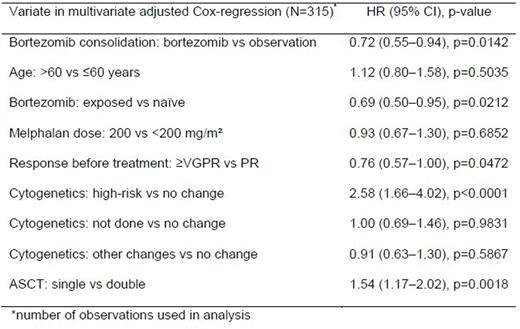Abstract
Background
High-dose therapy (HDT) with autologous stem cell transplantation (ASCT) is the established standard-of-care for patients with newly diagnosed multiple myeloma (NDMM) who are young and/or fit. The number of older patients receiving HDT-ASCT is increasing, although they often receive lower-intensity treatment. Novel agent-based consolidation therapy can be used to improve responses following ASCT and prolong progression-free survival (PFS). The proteasome inhibitor bortezomib, given as post-ASCT consolidation therapy, resulted in an improved PFS compared with observation alone (median 33.6 vs 27.8 months, adjusted hazard ratio [HR] 0.70, p=0.0058) in a combined analysis of two phase 3 trials (MMY3012 [DSMM XIb; NCT00416273] and MMY3013 [DSMM X; NCT00416208]; JCO 2015;33:8511). These studies enrolled 222 patients aged ≤60 years and 158 aged >60 years. In this post-hoc analysis we investigated the effect of age and related treatment factors on PFS in more detail.
Methods
In both trials, 371 patients were randomized 1:1 following ASCT to receive four 35-day cycles of bortezomib consolidation (n=186; bortezomib 1.6 mg/m2 IV administered on days 1, 8, 15, and 22) or observation (n=185; no treatment). The primary endpoint was PFS from the start of induction chemotherapy. Response and progression were assessed at the start of each bortezomib cycle and at the end-of-treatment/observation visit (week 25), as well as during the follow-up period of 30-60 months. Patient characteristics and treatments were compared between trials; PFS following randomization was assessed separately for each study. Univariate, bivariate, and multivariate Cox regressions were conducted to evaluate the impact of treatment group, age (≤60 vs >60 years), single vs tandem ASCT, melphalan conditioning dose (MEL <200 vs 200 mg/m2), bortezomib exposure during induction (exposed vs naïve), post-ASCT response (partial response vs ≥very good partial response [VGPR]), and cytogenetics on PFS.
Results
A number of relevant factors were different between age groups (median age in ≤60 group 53 years vs 66 years in >60 group), including the HDT regimen received (MEL100 7% vs 10%; MEL140 3% vs 59%; MEL200 88% vs 31%). The rate of double transplantation was similar for the younger and older cohorts (55% vs 59%), likely due to the older patients receiving age-adjusted high-dose melphalan with a lower toxicity, allowing a similar rate of double transplantation as younger patients receiving MEL200. Among the 357 patients included in these analyses, median PFS from start of induction was 33.6 vs 27.8 months with bortezomib consolidation vs observation (log-rank p=0.0243). Median PFS for bortezomib vs observation was 33.6 vs 29.0 months (HR 0.86; p=0.3599) in the younger cohort and 33.4 vs 26.4 months (HR 0.60; p=0.0073) in the older cohort. PFS for older patients who received bortezomib consolidation was very similar to PFS in younger patients (p=0.861); survival curves were superimposable despite the older patients having received less intensive pretreatment. Univariate analysis demonstrated that treatment group (bortezomib vs observation) had an effect on PFS (HR 0.75; exploratory p-value <0.05), as did age (>60 vs ≤60 years; HR 1.30), melphalan dose (200 vs <200 mg/m2; HR 0.74), single vs tandem ASCT (HR 1.35), and cytogenetics (high-risk vs no change; HR 2.62). On bivariate analysis of treatment group plus other covariates, the PFS benefit of bortezomib consolidation vs observation remained consistent (HR 0.71-0.76) across analyses with other covariates. On multivariate Cox regression analysis (Table), bortezomib consolidation (HR 0.72), prior bortezomib during induction (HR 0.69), ≥VGPR post-ASCT (HR 0.76), high-risk cytogenetics (HR 2.58), and single vs tandem ASCT (HR 1.54) were independent prognostic factors for PFS.
Conclusions
For patients with NDMM, bortezomib consolidation post-ASCT appeared to equalize the outcome for older patients who had received less intensive pretreatment than younger patients prior to randomization. A consistent PFS benefit was demonstrated with bortezomib consolidation vs observation in the context of other prognostic factors. In a multivariate analysis, the use of tandem transplantation retained independent prognostic relevance, whereas MEL200 as first HDT did not.
Straka:Celgene: Consultancy, Honoraria, Membership on an entity's Board of Directors or advisory committees, Other: Travel/Accommodation/Expenses, Research Funding; Janssen: Honoraria, Membership on an entity's Board of Directors or advisory committees; Onyx: Consultancy, Honoraria, Membership on an entity's Board of Directors or advisory committees, Other: Travel/Accommodation/Expenses; Chugai: Research Funding. Knop:Takeda: Consultancy. Vogel:Janssen-Cilag GmbH: Employment. Kropff:Celgene: Consultancy, Other: Travel/Accommodation/Expenses, Speakers Bureau; Janssen: Consultancy, Other: Travel/Accommodation/Expenses, Speakers Bureau; Onyx: Consultancy, Speakers Bureau. Metzner:Amgen: Consultancy; Sanofi: Consultancy; Celgene: Other: Travel/Accommodation/Expenses; Takeda: Other: Travel/Accommodation/Expenses. Langer:Celgene: Consultancy; Takeda: Consultancy; Janssen: Consultancy; Amgen: Consultancy; Novartis: Consultancy. Sayer:Riemser Pharma: Consultancy. Bassermann:Celgene: Other: Travel/Accommodation/Expenses. Gramatzki:Janssen: Other: Travel/Accommodation/Expenses, Research Funding. Rösler:Janssen: Consultancy, Other: Travel/Accommodation/Expenses. Engelhardt:MSD: Consultancy, Honoraria; Janssen: Consultancy, Honoraria; Celgene: Consultancy, Honoraria, Other: Travel/Accommodation/Expenses , Research Funding. Fischer:Novartis: Consultancy, Honoraria. Einsele:Celgene: Consultancy, Honoraria, Other: Travel/Accommodation/Expenses , Research Funding, Speakers Bureau; Janssen: Consultancy, Honoraria, Other: Travel/Accommodation/Expenses , Research Funding, Speakers Bureau; Novartis: Consultancy, Other: Travel/Accommodation/Expenses , Speakers Bureau; Amgen: Consultancy, Speakers Bureau.
Author notes
Asterisk with author names denotes non-ASH members.


This feature is available to Subscribers Only
Sign In or Create an Account Close Modal